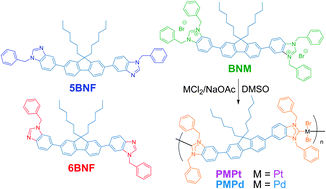Organometallic polymers based on fluorene-bridged bis-benzimidazolylidene via direct ligand–metal coordination: synthesis, characterization and optical properties†
Abstract
To develop new organometallic

* Corresponding authors
a
Department of Chemical Engineering, National Cheng Kung University, Tainan, Taiwan
E-mail:
yunchen@mail.ncku.edu.tw
Fax: +886 6 2344496
Tel: +886 6 2085843
b Research Center for Energy Technology and Strategy, National Cheng Kung University, Tainan, Taiwan
To develop new organometallic

 Please wait while we load your content...
Something went wrong. Try again?
Please wait while we load your content...
Something went wrong. Try again?
C. Wu, Y. Lee and Y. Chen, Polym. Chem., 2012, 3, 2776 DOI: 10.1039/C2PY20360J
To request permission to reproduce material from this article, please go to the Copyright Clearance Center request page.
If you are an author contributing to an RSC publication, you do not need to request permission provided correct acknowledgement is given.
If you are the author of this article, you do not need to request permission to reproduce figures and diagrams provided correct acknowledgement is given. If you want to reproduce the whole article in a third-party publication (excluding your thesis/dissertation for which permission is not required) please go to the Copyright Clearance Center request page.
Read more about how to correctly acknowledge RSC content.
 Fetching data from CrossRef.
Fetching data from CrossRef.
This may take some time to load.
Loading related content
